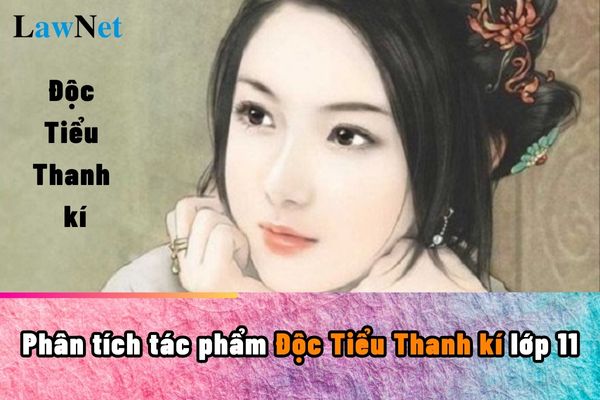What are guidelines on analysis of the literary work "Độc Tiểu Thanh kí" for grade 11 students in Vietnam? What are the responsibilities of upper secondary school students in Vietnam?
What are guidelines on analysis of the literary work "Độc Tiểu Thanh kí" for grade 11 students in Vietnam?
"Độc Tiểu Thanh kí" is one of the texts that students will study in the grade 11 Literature curriculum.
Students can refer to the following guidelines on analysis of the literary work "Độc Tiểu Thanh kí".
|
Analysis of the literary work "Độc Tiểu Thanh kí" for grade 11 students *The Author's Emotions Before the Tragic Fate of Tieu Thanh |
*Note: The information about the analysis of the poem "Độc Tiểu Thanh kí" is for reference only./.

What are guidelines on analysis of the literary work "Độc Tiểu Thanh kí" for grade 11 students in Vietnam? (Image from the Internet)
What are the responsibilities of upper secondary school students in Vietnam?
Based on Article 34 of the regulations for lower secondary schools, upper secondary schools, and multi-level schools issued by the Ministry of Education and Training with Circular 32/2020/TT-BGDDT, the responsibilities of upper secondary school students in Vietnam include:
- Fulfill the study and training tasks according to the school's educational program and plan.
- Show respect to parents, staff, teachers, school staff, and adults; unite and help each sother in learning and training; adhere to school regulations and rules; comply with the laws of the State.
- Train physically, maintain personal hygiene.
- Participate in collective activities at school, class, Ho Chi Minh Young Pioneers, and Ho Chi Minh Communist Youth Union; assist the family, engage in labor and social activities, environmental protection activities, maintain traffic safety.
- Preserve and protect school and public property; contribute to building, protecting, and promoting the school's traditions.
What are the optional ubjects for grade 11 students in Vietnam?
According to Section 3 of the general education program issued with Circular 32/2018/TT-BGDDT:
1. Basic Education Stage
1.1. Primary Level
a) Educational Content
Compulsory subjects and educational activities: Vietnamese; Mathematics; Ethics; Foreign Language 1 (in grades 3, 4, 5); Natural and Social Science (in grades 1, 2, 3); History and Geography (in grades 4, 5); Science (in grades 4, 5); IT and Technology (in grades 3, 4, 5); Physical Education; Arts (Music, Fine Arts); Experiential Activities.
Optional subjects: Ethnic Minority Languages, Foreign Language 1 (in grades 1, 2).
b) Educational Duration
Two-session day teaching is implemented, with no more than 7 periods/day; each period is 35 minutes. Educational institutions not yet capable of organizing two-session day teaching follow the educational plan guided by the Ministry of Education and Training.
...
1.2. Lower Secondary Level
a) Educational Content
Compulsory subjects and educational activities: Literature; Mathematics; Foreign Language 1; Civic Education; History and Geography; Natural Science; Technology; IT; Physical Education; Arts (Music, Fine Arts); Experiential and career-oriented activities; Local educational content.
Optional subjects: Ethnic Minority Languages, Foreign Language 2.
b) Educational Duration
...
2. Career Orientation Education Stage
2.1. Educational Content
Compulsory subjects and educational activities: Literature; Mathematics; Foreign Language 1; History; Physical Education; National Defense and Security Education; Experiential and career-oriented activities; Local educational content.
Elective subjects: Geography, Economic and Legal Education, Physics, Chemistry, Biology, Technology, IT, Music, Fine Arts.
Students choose 4 elective subjects from the elective subjects.
...
The optional subjects for grade 11 (upper secondary school) students include 4 subjects: Geography, Economic and Legal Education, Physics, Chemistry, Biology, Technology, IT, Music, Fine Arts.
>>> Download General Education Program issued with Circular 32/2018/TT-BGDDT.
(Note: Some content in this article is amended by Article 1, Article 2 Circular 13/2022/TT-BGDDT)

